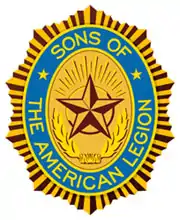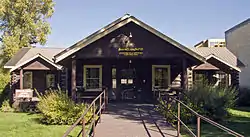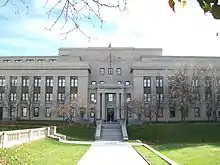Sons of the American Legion
The Sons of the American Legion is a patriotic service organization formed on September 12–15, 1932. The S.A.L. is made up of male descendants of people who served in the United States Armed Forces during times specified by the American Legion.[1] The Sons of the American Legion's mission to serve veterans, the military and their families is carried out through its hundreds of outreach programs delivered by its members, volunteers and national headquarters.[2] The Sons of the American Legion's national headquarters is located in Indianapolis.
 Emblem | |
| Motto | "For God and Country" |
|---|---|
| Established | September 12–15, 1932; 83 years ago |
| Type | Patriotic-Hereditary society |
| Legal status | Federally chartered corporation |
| Purpose | Patriotic, fraternal, benevolent |
| Headquarters | 700 N. Pennsylvania St., Indianapolis, Indiana |
| Coordinates | 39.776996°N 86.156201°W |
Region served | Worldwide |
Membership (2016) | 367,948 |
Official language | English |
National Commander | Clint Bolt |
National Adjutant | Anthony Wright |
Parent organization | The American Legion |
| Affiliations |
|
| Website | legion |
Mission
Their main mission is to sponsor programs that its parent organization, The American Legion, does to improve veterans communities, such as scholarships, veterans help programs (i.e. ending veterans homelessness), and youth sports.[3] They also promote national security, patriotism, and devotion to veterans.[4]
History
Beginnings
The establishment of the Sons of the American Legion as a non-political, no-sectarian civilian organization was authorized by action of the 14th National Convention of the American Legion in Portland, Oregon September 12–15, 1932.
In 1939, the S.A.L. was riding the crest and had a numerical size of about seven percent as large as the parent organization. The S.A.L. organization seemed destined to grow even larger, but looming on the horizon was World War II. With the passing of time, thousands of young men suddenly found themselves old enough to be in the armed services.
Many of the S.A.L. members never returned from World War II and those that did found that their service had made them eligible to join the ranks of the American Legion itself, which, in 1942 opened the door to the returning World War II veterans.
Membership dropped from a high of 72,633 in 1939 to a low of 5,631 in 1953. Many factors caused the lean years for the S.A.L. program. The former S.A.L., now veterans of World War II, had no grown children in the immediate postwar years. Housing shortages, a nation on the move, the G.I. Bill that sent thousands of veterans back to school, and the Korean War that put reservists back in uniform were some of the contributing factors.
1960–present
However, by 1963, enrollment had climbed to nearly 17,000. In noting this renewed growth, the National Executive Committee, in regular meetings assembled in Indianapolis, Indiana, April 30 – May 1, 1964, [passed Resolution 22, urging that the S.A.L. program "be encouraged and implemented by internal promotion and increased public recognition through the national Headquarters staff and the various Departments of the American Legion." Approval was given for the S.A.L. to conduct their first National S.A.L. Workshop during the Legion's National Convention in Dallas, Texas in 1964.
In noting a need for a small national body to give the S.A.L. program national direction and stimulation, the Legion's NEC gave its approval to Resolution 60 at its May 8–9, 1969, meeting in St. Louis, Missouri. Resolution 60 created a four-member Sons of the American Legion Committee.
After conducting a long and detailed study of the over-all organizational structure of the S.A.L., the Sons of the American Legion Committee reported that there was a "definite need for a national Sons of the American Legion organization and the updating of the National Constitution and By-Laws of the S.A.L., as approved by the Legion's NEC back in May 1933, and be subsequently amended".
At its fall meeting in Indianapolis, IN, October 17–18, 1973, the Legion gave its approval to Resolution 15, abolishing the National S.A.L. Committee created by Resolution 60 by the Legion's NEC at its meeting May 8–9, 1969, in St. Louis, MO. Residual responsibilities of the National S.A.L. Committee are now assigned to the Legion's National Internal Affairs Commission.
Since 1988, The Sons have raised more than $7 million for the American Legion Child Welfare Foundation.[1]
In early to mid 2014, mySAL was launched to Sons of the American Legion squadron adjutants can now access membership information, reports and electronic membership tools online.
As of 2016, the membership total is over 360,000.[1]
Programs
At the state level, the S.A.L. is organized into "departments", which run annual civic training events for high school juniors called Boys State. Two members from each Boys State are selected for Boys Nation. The American Legion Auxiliary runs Girls State and Girls Nation. In addition to Boys State, the S.A.L., division of the American Legion, features numerous programs including American Legion Baseball, Scouting, Oratorical Contests, Junior Shooting Sports, Youth Alumni, the American Legion Riders, and Scholarships at every level of the organization.
Membership eligibility requirements
All male descendants, adopted sons and stepsons of members of The American Legion, and such male descendants of veterans who died in service during World War I or since December 7, 1941, during the delimiting periods set forth in Article IV, Section 1, of the National Constitution of The American Legion or who died subsequent to their honorable discharge from such service, shall be eligible for membership in the Sons of The American Legion.[5]
- Because eligibility dates remain open, all active duty members of the U.S. Armed Forces are eligible to join The American Legion at this time, until the date of the end of hostilities as determined by the government of the United States.
- U.S. Merchant Marine eligible only from December 7, 1941 to December 31, 1946 (WWII).
Organizational structure

Squadron
The squadron is the basic unit of the Legion and usually represents a small geographic area such as a single town or part of a county. There are roughly 14,900 posts in the United States. The squadron is used for formal business such as meetings and a coordination point for community service projects. Often the squadron will host community events such as bingo, Hunter breakfasts, holiday celebrations, and available to the community, churches in time of need. It is also not uncommon for the Post to contain a bar open during limited hours. An S.A.L. squadron member is distinguished by a French blue garrison cap with red, white and blue piping.
Counties
Each U.S. county comprises several squadrons and oversees their operations, led by a County Council of elected officers. The County Commander performs annual inspections of the Posts within their jurisdiction and reports the findings to both the District and the Department level. An S.A.L. County member is distinguished by a French blue garrison cap with white piping.
Districts
Each squadron is divided into Divisions and/or Districts. Each District oversees several squadrons, generally about 20, to help each smaller group have a larger voice. Divisions are even larger groups of about four or more Districts. The main purpose of these "larger" groups (Districts—Divisions) is to allow one or two delegates to represent an area at conferences, conventions, and other gatherings, where large numbers of Legionnaires may not be able to attend. A District member is distinguished by a French blue garrison cap with a white crown and red, white and blue piping.
Detachments
The squadrons are grouped together into a state level organization known as a Detachment for the purposes of coordination and administration. There is a total of 55 Detachments; one for each of the 50 states, the District of Columbia, Puerto Rico, France, Mexico, and the Philippines. Canada was merged into Department of New York several years ago. The three Detachments located overseas are intended to allow active duty military stationed and veterans living overseas to be actively involved with the American Legion similar to as if they were back in the States. The Detachment of France consists of 29 Posts located in 10 European counties, the Detachment of Mexico consists of 22 Posts located in Central America, and the Detachment of Philippines covers Asia and the Pacific Islands. A Detachment member is distinguished by a French blue garrison cap with a gold crown and red, white and blue piping.
National headquarters

The main S.A.L. Headquarters is located on the Indiana World War Memorial Plaza in Indianapolis. It is the primary office for the National Commander and also houses the historical archives, library, Membership, Internal Affairs, Public Relations, and the Magazine editorial offices. The Legion also owns a building in Washington D.C. that contains many of the operation offices such as Economics, Legislative, Veterans Affairs, Foreign Relations, National Security, and Media Relations. A National member is distinguished by a gold garrison cap with a gold crown and red, white and blue piping.
mySAL
National Headquarters developed the website to mimic myLegion, which assists a post, district, county, and state officers with their membership needs. Download an authorization form at mySAL to start the process of creating a squadron account. Once an account is created, you can login here: mySAL.Sons of the American Legion squadron adjutants can now access membership information, reports and electronic membership tools online. As of April 2015, Detachments now have access to the website which provides membership information, reports and electronic membership tools such as data change forms for all squadrons within their Detachment.[6]
Past S.A.L. Commanders
The following list is from the S.A.L. website:[7]
1970–1979
| Year | Name | State from | Notes |
|---|---|---|---|
| 1970–71 | J.R. Stillwell | IL | |
| 1972 | John Smolinsky | MA | |
| 1973 | Robert Faust | CA | |
| 1974 | James Hartman | MD | |
| 1975 | Gregory D. Reis | IL | |
| 1976 | Grant M. Jamieson | MI | |
| 1977 | Charles E. Gannon | MD | |
| 1978 | John M. Sherrard | CA | |
| 1979 | Richard J. Kepler | AZ | Deceased |
1980–1989
| Year | Name | State from | Notes |
|---|---|---|---|
| 1980 | Ernest Wilson, Jr. | NJ | Deceased |
| 1981 | Donald L. Willson | PA | Deceased |
| 1982 | David P. Stephens | IN | |
| 1983 | Christopher R. Cerullo | NY | |
| 1984 | Fred L. Hartline | OH | |
| 1985 | Woodrow L. Mudge, Jr. | CO | Deceased |
| 1986 | Royce Doucet | LA | Deceased |
| 1987 | Douglas P. Bible | MN | |
| 1988 | Richard L. League | MD | |
| 1989 | David R. Faust | WI | |
1990–1999
| Year | Name | State from | Notes |
|---|---|---|---|
| 1990 | Charles R. Belles | VA | |
| 1991 | Robert A. Worrel | IN | |
| 1992 | Eugene L. Sacco | CA | |
| 1993 | Charles B. Rigsby | MI | Deceased |
| 1994 | Roland D. Matteson | AZ | |
| 1995 | Joseph M. Mayne | MN | |
| 1996 | John T. Dietz | KY | |
| 1997 | Jack E. Jordan | TX | |
| 1998 | William E. Matoska | MD | |
| 1999 | Byron Robichaux | LA | |
2000–2020
| Year | Name | State from | Notes |
|---|---|---|---|
| 2000 | Richard L. Cook | OK | |
| 2001 | Kevin N. Winkelmann | TX | |
| 2002 | Clifford A. Smith | MA | |
| 2003 | Steve C. Laws | NC | |
| 2004 | Neal C. Warnken | KS | |
| 2005 | Michael J. Deacon | IA | |
| 2006 | William L. Sparwasser | MD | |
| 2007 | Earl R. Ruttkofsky | MI | |
| 2008 | Raymond P. Giehll Jr. | IN | |
| 2009 | Patrick J. Shea | OH |
|
| 2009 | Thomas E. Cisna | IL | |
| 2010 | Mark E. Arneson | GA | |
| 2011 | David L. Dew | TX | |
| 2012 | James K. Roberts III | FL | |
| 2013 | Christopher J. Huntzinger | PA | |
| 2014 | Joseph W. Gladden | MD | |
| 2015 | Mike W. Moss | CO | |
| 2016 | Kevin L. Collier | AK | |
| 2017 | Jeff Frain | AZ | |
| 2018 | Danny Smith | NE | |
| 2019 | Greg "Doc" Gibbs | NY | |
| 2020 | Clint D. Bolt | VA | |
See also
References
- "History of Sons of the American Legion". Retrieved March 6, 2015.
- "American Legion". Encyclopædia Britannica. Retrieved March 6, 2015.
- "Program". The American Legion. Retrieved March 6, 2015.
- "About". The American Legion. Retrieved March 6, 2015.
- https://www.legion.org/sons/join
- "National Update Official Publication of the Sons of The American Legion Spring 2015" (PDF). legion.org. Retrieved November 1, 2015.
- "Past Commanders". legion.org/sons. Retrieved March 6, 2015.